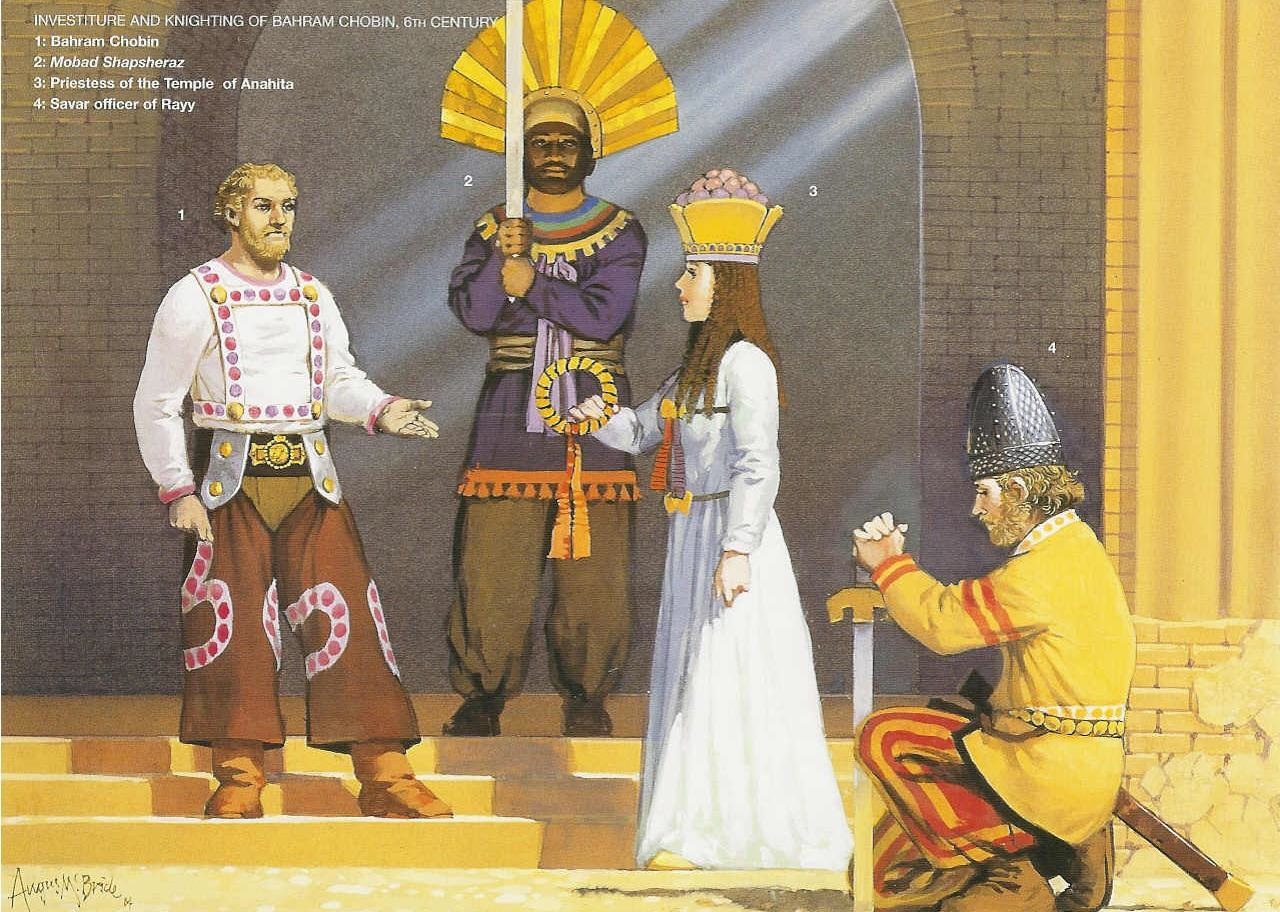The article below by Shapour Suren-Pahlav titled “Anahita: The Deity of Water, Fertility, Healing and Wisdom” was posted originally in the London-based CAIS website.
Kindly note that a number of pictures displayed in the article below are from Kaveh Farrokh’s lectures at the University of British Columbia’s Continuing Studies Division , Stanford University’s WAIS 2006 Critical World Problems Conference Presentations on July 30-31, 2006; Farrokh’s textbook Shadows in the Desert: Ancient Persia at War-Персы: Армия великих царей-سایههای صحرا-) as well as venues such as the Civilization Fanatics Center and Ancientbattles.com.
=========================
Anahita is the name of a popular Zoroastrian yazatā and an ancient Iranian cosmological figure venerated as the female guardian angel of waters (Ābān), associated with fertility, healing and wisdom. Her name is (Avestan) Ardәwī Sūrā Anāhitā, (Old-Persian) Anāhitā, (Middle-Persian) Ardwīsūr Anāhīd (New-Persian) Nāhīd. In Armenia she is called Anāhit and Greeco-Roman historians refer to her either as Anāitis or identified her with one of the divinities from their own pantheons.
An iconic shrine cult of Aredvi Sura Anahita was – together with other shrine cults- “introduced apparently in the 4th century BCE and lasted until suppressed
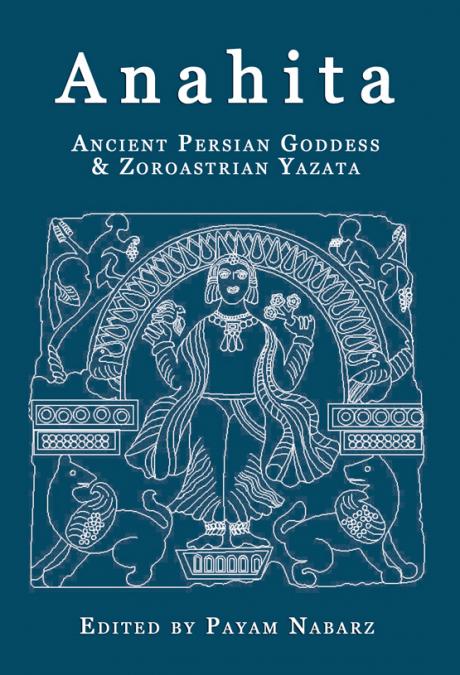 New Book: Anahita-Ancient Persian Goddess & Zoroastrian Yazata (edited by Payam Nabarz) – for more click here…
New Book: Anahita-Ancient Persian Goddess & Zoroastrian Yazata (edited by Payam Nabarz) – for more click here…
Etymology
Only Arədvī is specific to the divinity (Boyce 1983, p. 1003), and for etymological reasons – could originally have meant ‘moist’. The words sūra and anāhīta are generic Avestan adjectives (Boyce 1982, p. 29) and respectively mean ‘mighty’ and ‘pure’ (Lommel 1927, p. 29; Boyce 1982, p. 202) or ‘immaculate’ (Boyce 1983, p. 1003). Both adjectives also appear as epithets of other divinities or divine concepts such as Haoma (Boyce 1926, p. 99) and the Fravashis (Boyce 1926, p. 133). Both adjectives are also attested in Vedic Sanskrit (cf. Monier-Williams 1898).
As a divinity of ‘the waters’, the yazata is of Indo-Iranian origin, according to Lommel related to Sanskrit Saraswatī that, like its proto-Iranian equivalent *Harahvatī, derives from Indo-Iranian *Sarasvatī (Lommel 1954, pp. 405-413; Boyce 1975a, p. 71; Boyce 1983, p. 1003). In its old Iranian form *Harahvatī, “her name was given to the region, rich in rivers, whose modern capital is Kandahar (Avestan Haraxvaitī, Old Persian Hara(h)uvati-, Greek Arachosia)”(Boyce 1983, p. 1003). “Like the Indian Saraswati, [Aredvi Sura Anahita] nurtures crops and herds; and is hailed both as a divinity and the mythical river that she personifies, ‘as great in bigness as all these waters which flow forth upon the earth’.”
In the Middle-Persian texts of the Sasanian and later eras, Arədvī Sūra Anāhīta appears as Ardwisur Anāhīd (Boyce 1983, p. 1003). No part of the name is attested in old Western Iranian languages (e.g. Old Persian) or even Elamite (Boyce 1982, p. 29; Boyce 1983, p. 1006).
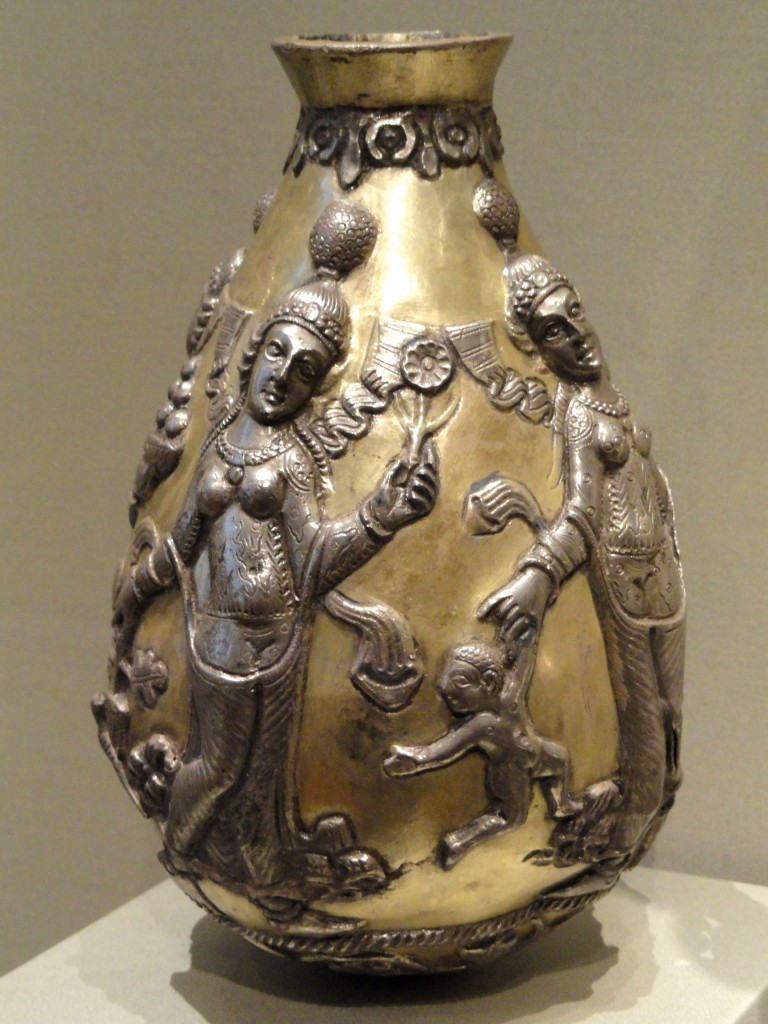 [Click to Enlarge] Silver-Gilt Sassanian vessel depicting the Goddess Anahita dated to the 4th-6th centuries CE (Picture Source: Public Domain).
[Click to Enlarge] Silver-Gilt Sassanian vessel depicting the Goddess Anahita dated to the 4th-6th centuries CE (Picture Source: Public Domain).
Historical Development
As the divinity of purifying waters, Aredvi Sura Anahita is associated with fertility, healing and wisdom. At some point prior to the 4th century BCE, this yazata was conflated with (an analogue of) Semitic Ishtar-Inanna (Boyce 1982, p. 202), likewise a divinity of “maiden” fertility and from whom Aredvi Sura Anahita then inherited additional features of a divinity of war and of the planet Venus. It was moreover the association with the planet Venus, “it seems, which led Herodotus to record that the Persis[1] learnt ‘to sacrifice to “the heavenly goddess”‘ from the Assyrians and Arabians” (Boyce 1982, p. 29 Cit; Herodotus, Histories i.131; Widengren 1965, p. 121; Nyberg 1938, p. 370).
However, Mary Boyce (1982:29-31) proposed that there was once a Perso-Elamite divinity named *Anahiti (Boyce 1982, p. 29) that was an analogue of Semitic Ishtar-Inanna – and that it is this divinity with which Aredvi Sura Anahita was conflated (Boyce 1982, p. 29). Boyce concludes that “the Achaemenids’ devotion to this goddess evidently survived their conversion to Zoroastrianism, and they appear to have used royal influence to have her adopted into the Zoroastrian pantheon” (Boyce 1983, pp. 1003-1004). Boyce’s theory, “the problem of how to offer veneration to a divinity unknown to the Avesta was solved by assimilating *Anāhiti to *Harahvaitī Arədvī Sūrā Anāhitā, whose third epithet was very close to the western divinity’s proper name, and indeed may already in late Old Persian have become identical with it, through the dropping of the final vowel in ordinary speech” (Boyce 1983, pp. 1003-1004).
In antiquity, “to invoke a deity correctly, it was essential to know his proper name” and when people “worshipped gods other than their own, they invoked them by their original names” (Bikerman 1938, p. 187). “That the concept [of *Anahiti] owes much to that of Ishtar was first suggested by H. Gressman (Archiv f. Religionswissenschaft XX, 1920, 35ff., 323ff; Boyce 1982, p. 29,n.93). An inheritance from Ishtar is also supported by Cumont (Cumont 1926, pp. 474ff) and Lommel (Lommel 1927, pp. 26-32). For a rejection of some of the numerous other identifications (Atargatis, Anat, etc.) as historically distinct (see Meyer 1886, pp. 330-334).
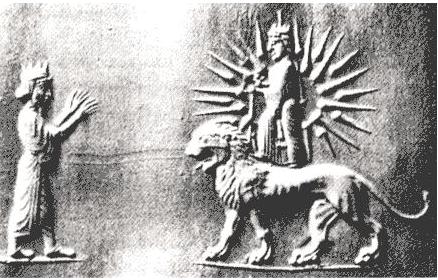 King Artaxerxes II (at left) facing the goddess Anahita who sits atop a lion (Picture Source: OwnerlessMind). In the background to Anahita can be seen the clear display of the sun which is a representation of the ancient Iranic god Mithras. Note that the sun emanates 21 rays, the same symbol which is used by varous ancient Iranic cults among the Kurds of Iran, Iraq and Turkey. The 21 rays may be related to the festival date of Mehregan (Festival of the Sun-god Mithra) which takes place from the 16th to the 21st of Mehr of the Iranian calendar.
King Artaxerxes II (at left) facing the goddess Anahita who sits atop a lion (Picture Source: OwnerlessMind). In the background to Anahita can be seen the clear display of the sun which is a representation of the ancient Iranic god Mithras. Note that the sun emanates 21 rays, the same symbol which is used by varous ancient Iranic cults among the Kurds of Iran, Iraq and Turkey. The 21 rays may be related to the festival date of Mehregan (Festival of the Sun-god Mithra) which takes place from the 16th to the 21st of Mehr of the Iranian calendar.
Ishtar also “apparently” also gave Aredvi Sura Anahita the epithet Banu (Persian) Bānū, ‘the Lady’, a typically Mesopotamian construct (Boyce 1983, p. 1006) that is not attested as an epithet for a divinity in Iran before the common era. It is completely unknown in the texts of the Avesta (Boyce 1983, p. 1006) but evident in Sasanian-middle-Persian inscriptions and in a middle Persian Zend translation of Yasna 68.13 (Darmesteter 1892, p. 419). Also in Zoroastrian texts from the post-conquest epoch (651 CE onwards), the divinity is referred to as ‘Anāhid the Lady’, ‘Ardwisur the Lady’ and ‘Ardwisur the Lady of the waters’ (Boyce 1967, p. 37).
Because the divinity is unattested in any old Western Iranian language (Boyce 1982, p. 29), establishing characteristics prior to the introduction of Zoroastrianism in Western Iran (c. 5th century BCE) is very much in the realm of speculation.
However, to an alternate theory, Anahita was perhaps “a daeva of the early and pure Zoroastrian faith, incorporated into the Zoroastrian religion and its revised canon” during the reign of “Artaxerxes I, the Constantine of that faith” (Taqizadeh 1938, p. 35). Although Taqizadeh’s hypothesis is not supportable in light of the archaic nature of the Gathic nucleus of Yasht 5, it is worth noting that Artaxerxes I (r. 465-424 BCE) moved his capital from Susa to Babylon, where it would remain until Artaxerxes II moved it back in 395 BCE. Darius II was half-Babylonian and died in Babylon. Darius’s son and successor, Artaxerxes II mother, Parysatis, who was immensely influential on both Darius and her sons (the other being Cyrus the Younger).
Widengren has a similar hypothesis, but places it in the Proto-Avestan period. In this opinion (Widengren 1965, p. 18), Anahita is Nahaithya, the Avestan daeva(s) that Widengren also suggests might be cognate with the Nasatyas.
Anahita as a Cosmological Entity
The cosmological qualities of the world river are alluded to in Yasht 5, but properly developed only in the Bundahishn, a Zoroastrian account of creation finished in the 11th or 12th century CE. In both texts, Aredvi Sura Anahita is not only a divinity, but also the source of the world river and the (name of the) world river itself. In the Bundahishn, the two halves of the name “Ardwisur Anahid” are occasionally treated independently of one another, that is, with Ardwisur as the representative of waters, and Anahid identified with the planet Venus: The water of the all lakes and seas have their origin with Ardwisur (10.2, 10.5), and in contrast, in a section dealing with the creation of the stars and planets (5.4), the Bundahishn speaks of Anahid i Abaxtari, that is, the planet Venus (Boyce 1983, p. 1004). In yet other chapters, the text equates the two, as in “Ardwisur who is Anahid, the father and mother of the Waters” (3.17).
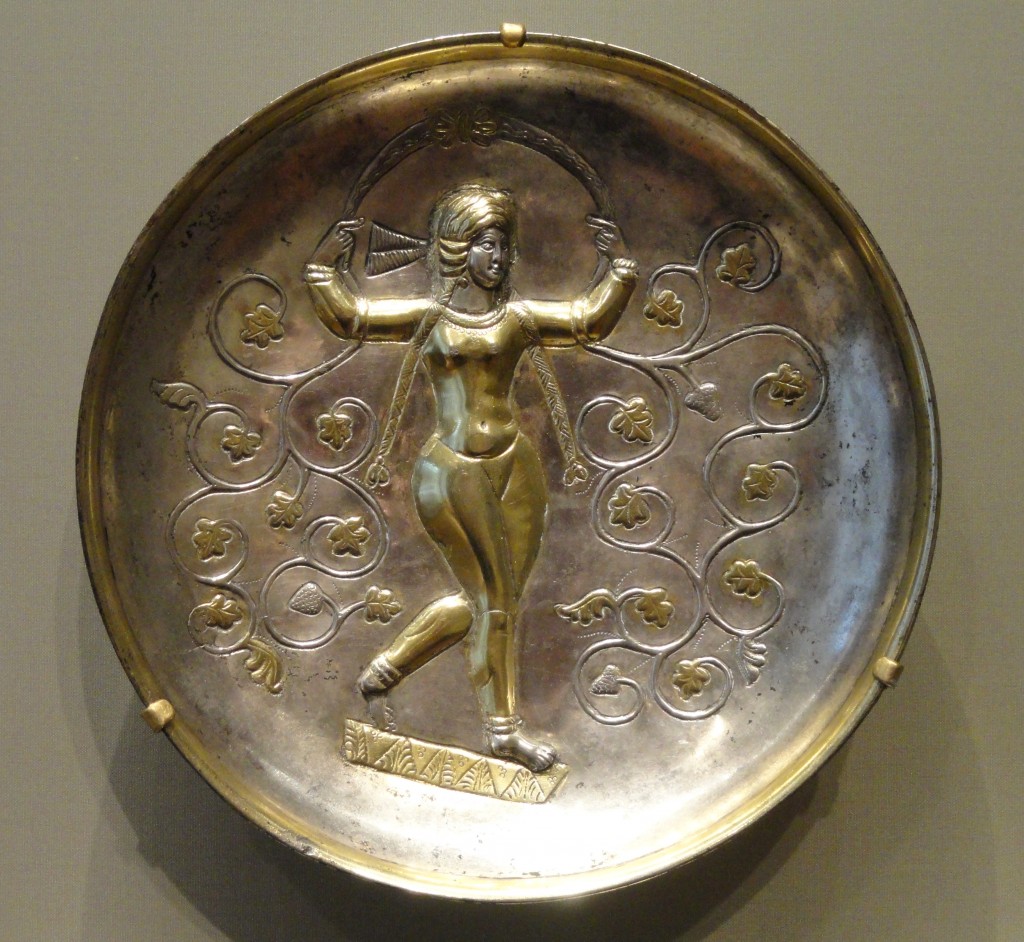 [Click to Enlarge] Sassanian dish dated to the 5th-7th centuries CE depicting the Goddess Anahita (Picture Source: Public Domain).
[Click to Enlarge] Sassanian dish dated to the 5th-7th centuries CE depicting the Goddess Anahita (Picture Source: Public Domain).
This legend of the river that descends from Mount Hara appears to have remained a part of living observance for many generations. A Greek inscription from Roman times found in Asia Minor reads ‘the great goddess Anaïtis of high Hara’ (Boyce 1975a, p. 74). On Greek coins of the imperial epoch, she is spoken of as ‘Anaïtis of the sacred water’ (Boyce 1983, p. 1004).
In the Avesta
Aredvi Sura Anahita is principally addressed in Yasht 5 (Yasna 65) , also known as the Aban Yasht, a hymn to the waters in Avestan and one of the longer and better preserved of the devotional hymns. Yasna 65 is the third of the hymns recited at the Ab-Zohr, the “offering to the waters” that accompanies the culminating rites of the Yasna service. Verses from Yasht 5 also form the greater part of the Aban Nyashes, the liturgy to the waters that are a part of the Khordeh Avesta.
According to Nyberg (Nyberg 1938, p. 260,291,438) and supported by Lommel (Lommel 1954, p. 406) and Widengren (Widengren 1955, p. 48), the older portions of the Aban Yasht were originally composed at a very early date, perhaps not long after the Gathas themselves. Boyce agrees: “Linguistically, Aredvi Sura’s hymn appears older than [the Gathic hymn of] Asi’s”(Boyce 1983, p. 1003). It “was presumably after [Artaxerxes II] that verses [that] describe a temple statue” were incorporated in Yasht 5 (Boyce 1983, p. 1004). Yasna 38, which is dedicated “to the earth and the sacred waters” and is part of seven-chapter Yasna Haptanghāiti, is linguistically as old as the Gathas.
In the Aban Yasht, the river yazata is described as “the great spring Ardvi Sura Anahita is the life-increasing, the herd-increasing, the fold-increasing who makes prosperity for all countries” (5.1). She is “wide flowing and healing”, “efficacious against the daevas”, “devoted to Ahura’s lore” (5.1). She is associated with fertility, purifying the seed of men (5.1), purifying the wombs of women (5.1), encouraging the flow of milk for newborns (5.2). As a river divinity, she is responsible for the fertility of the soil and for the growth of crops that nurture both man and beast (5.3). She is a beautiful, strong maiden, wearing beaver skins (5.3,7,20,129).
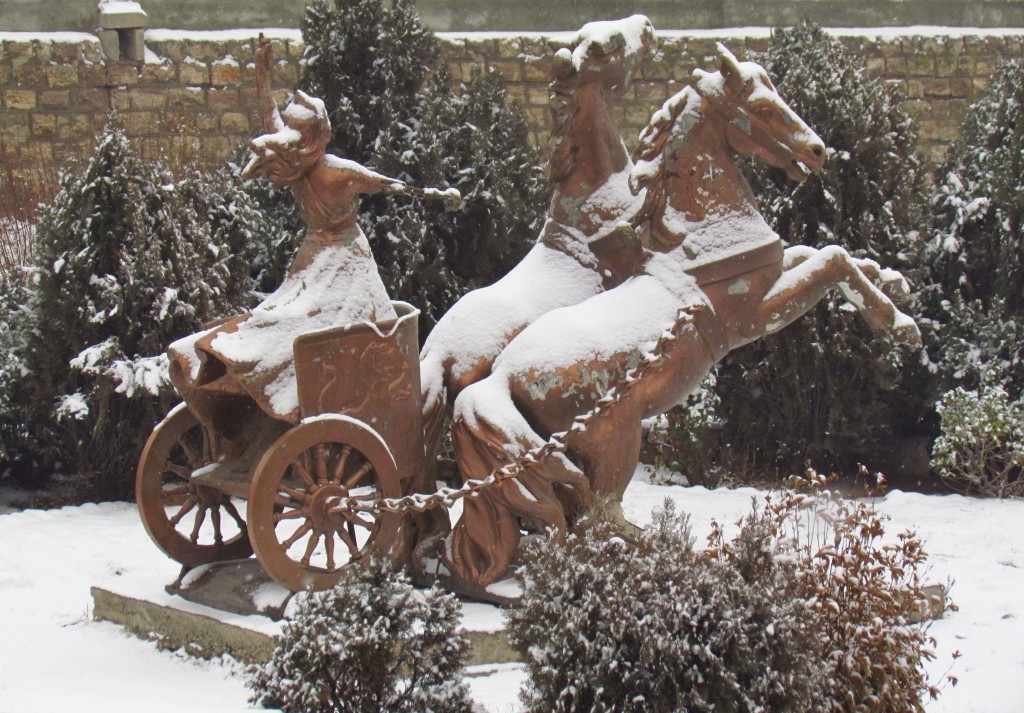 Statue of Anahita in Maragheh, in Iran’s east Azarbaijan province (Picture Source: Public Domain).
Statue of Anahita in Maragheh, in Iran’s east Azarbaijan province (Picture Source: Public Domain).
The association between water and wisdom that is common to many ancient cultures is also evident in the Aban Yasht, for here Aredvi Sura is the divinity to whom priests and pupils should pray for insight and knowledge (5.86). In verse 5.120 she is seen to ride a chariot drawn by four horses named ‘wind’, ‘rain’, ‘clouds’ and ‘sleet’. In newer passages she is described as standing in ‘statuesque stillness’, ‘ever observed’, royally attired with a golden embroidered robe, wearing a golden crown, necklace and earrings, golden breast-ornament, and gold-laced ankle-boots (5.123, 5.126-8). Aredvi Sura Anahita is bountiful to those who please her, stern to those who do not, and she resides in ‘stately places’ (5.101).
The concept of Aredvi Sura Anahita is to a degree blurred with that of Ashi, the Gathic figure of Good Fortune, and many of the verses of the Aban Yasht also appear in Yasht 17 (Ard Yasht), which is dedicated to Ashi. So also a description of the weapons bestowed upon worshippers (5.130), and the superiority in battle (5.34 et al). These functions appears out of place in a hymn to the waters (Boyce 1983, p. 1003), and may have originally been from Yasht 17.
Other verses in Yasht 5 have masculine instead of feminine pronouns, and thus again appear to be verses that were originally dedicated to other divinities (Boyce 1975a, p. 73). Boyce also suggests that the new compound divinity of waters with martial characteristics gradually usurped the position of Apam Napat, the great warlike water divinity of the Ahuric triad, finally causing the latter’s place to be lost and his veneration to become limited to the obligatory verses recited at the Ab-Zohr.
The Cult of Anahita
The earliest dateable and unambiguous reference to the iconic cult of Anahita is from the Babylonian scholar-priest Berosus, who – although writing over 70 years after the reign of Artaxerxes II Mnemon (a Greek epithet, roughly translatable as ‘the mindful one’, but is itself a mistranslation of Vohu Manah, the Amesha Spenta of ‘Good Mind’ or ‘Good Purpose’ “Arjomand 1998, pp. 246-247”) – records that the emperor had been the first to make cult statues of ‘Aphrodite Anaitis’ and placed them in temples in many of the major cities of the empire, including Babylon, Susa, Ecbatana, Persepolis, Damascus and Sardis (Berosus, III.65). Also according to Berosus, the Persians knew of no images of gods until Artaxerxes II erected those images (Berosus, III.65). (See also Müller’s Fragmenta Historicorum Graecorum, 16) This is substantiated by Herodotus, for in his mid-5th century BCE general remarks on ‘the usages of the Perses’, Herodotus notes that “it is not their custom to make and set up statues and images and altars, and those that make such they deem foolish, as I suppose, because they never believed the gods, as do the Greeks, to be the likeness of men” (Herodotus, Histories i.131; Boyce 1975b, p. 456; Boyce 1982, p. 179).
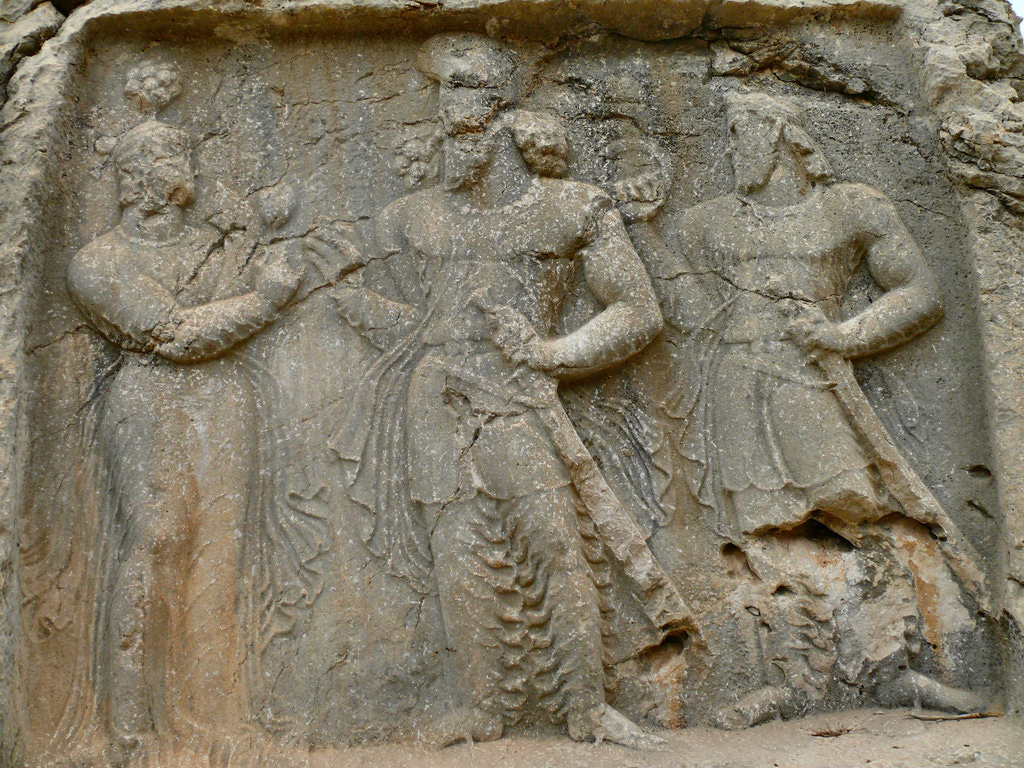 [Click to Enlarge] An image of Ardashir I or Bahram II (middle) and prince Shapur I or Bahram III “Sakan Shah [King of the Sakas]” (at right) and what appears to be Goddess Anahita (or a Sassanian Queen) (Picture Source: Atefeh Ashrafian, 2009).
[Click to Enlarge] An image of Ardashir I or Bahram II (middle) and prince Shapur I or Bahram III “Sakan Shah [King of the Sakas]” (at right) and what appears to be Goddess Anahita (or a Sassanian Queen) (Picture Source: Atefeh Ashrafian, 2009).
The extraordinary innovation of the shrine cults can thus be dated to the late 5th century BCE (or very early 4th century BCE), even if this evidence is “not of the most satisfactory kind” (Boyce 1982, p. 202). Nonetheless, by 330 BCE and under Achaemenid royal patronage, these cults had been disseminated throughout Asia Minor and the Levant, and from there to Armenia (Boyce 1983, p. 1004). This was not a purely selfless act, for the temples also served as an important source of income. From the Babylonian kings, the Achaemenids had taken over the concept of a mandatory temple tax, a one-tenth tithe which all inhabitants paid to the temple nearest to their land or other source of income (Dandamaev & Lukonin 1989, pp. 361-362). A share of this income called the quppu ša šarri, “kings chest” – an ingenious institution originally introduced by Nabonidus – was then turned over to the ruler.
Nonetheless, Artaxerxes’ close connection with the Anahita temples is “almost certainly the chief cause of this king’s long-lasting fame among Zoroastrians, a fame which made it useful propaganda for the succeeding Arsacids to claim him (quite spuriously) for their ancestor” (Boyce 1982, p. 221; Arjomand 1998, p. 247).
Anahita as a Goddess in Pars, Elam and Media
Artaxerxes II’s devotion to Anahita is most apparent in his inscriptions, where her name appears directly after that of Ahura Mazda and before that of Mithra. Artaxerxes’ inscription at Susa reads: “By the will of Ahura Mazda, Anahita, and Mithra I built this palace. May Ahura Mazda, Anahita, and Mithra protect me from all evil” (A²Hc 15-10). This is a remarkable break with tradition; no Achaemenid king before him had invoked any but Ahura Mazda alone.
The temple of Anahita at Ecbatana[2] (Hamadan) in Media must have once been the most glorious sanctuaries in the known world (Isidore of Charax, Parthian Stations 6). The temple with its vast palace, four-fifths of a mile in circumference, built of cedar or cypress. In all of it, not a single plank or column stood but was covered by plates of silver or gold. Every tile of the floors was made of silver, and the whole building was apparently faced with bricks of silver and gold. The temple was plundered by Alexander of Macedon and stripped by the following Seleucid rulers during the reigns of Antigonus (r. 325-301 BCE) and Seleucus Nicator (r. 312-280 BCE) (Polybius, Histories 10.27.11); – when Antiochus III raided Ecbatana in 209 BCE, the temple “had the columns round it still gilded and a number of silver tiles were piled up in it, while a few gold bricks and a considerable quantity of silver ones remained” (Polybius, Histories 10.27.12).
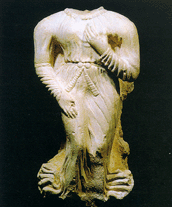 Depiction of Izad-Banu in the 4th millennium in modern-day Fars province (Photo Source: CAIS).
Depiction of Izad-Banu in the 4th millennium in modern-day Fars province (Photo Source: CAIS).
Polybius’ reference to Alexander is supported by Arrian, who in 324 BCE wrote of a temple in Ecbatana dedicated to ‘Asclepius’ (by inference presumed to be Anahita, likewise a divinity of healing), destroyed by Alexander because she had allowed his male lover and companion Hephaestion to die (Arrian, Anabasis of Alexander 7.14). The massive stone lion on the hill there perhaps a sepulchral monument to his lover Hephaestion is today a symbol that visitors touch in hope of fertility.
Plutarch records that Artaxerxes II had his concubine Aspasia consecrated as priestess at the temple “to Diana of Ecbatana, whom they name Anaitis, that she might spend the remainder of her days in strict chastity” (Plutarch[3], Artaxerxes 27). This does not however necessarily imply that chastity was a requirement of Anaitis priestesses. “It is impossible (in the absence of contemporary Iranian evidence) to know the limits of what is implied here – whether, that is, all priestesses of Anahita were required at this epoch to be chaste for life, or only certain among them. Celibacy is not in general a state respected by Zoroastrians, or regarded by them as meritorious” (Boyce 1982, p. 220).
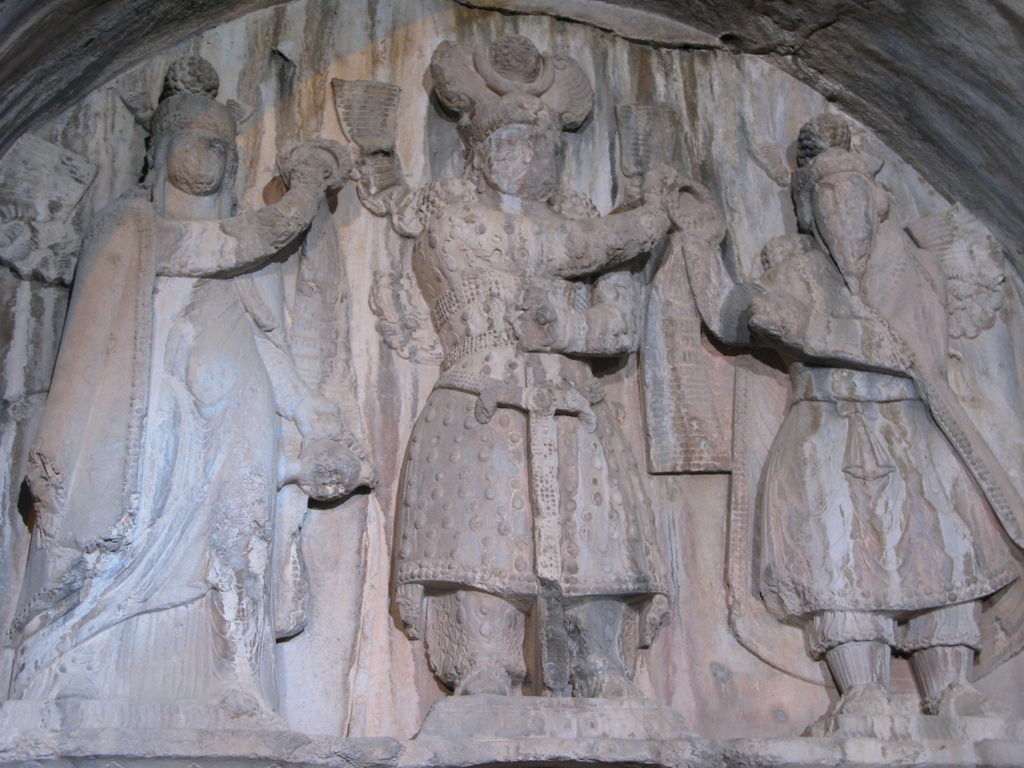 [Click to Enlarge] Investiture scene above the late Sassanian armored knight at the vault at Tagh-e Bostan. To the left stands Goddess Anahita with her right hand raised, holding a diadem of glory or “Farr” towards Khosrow II at center who receives a diadem with his right hand from Ahura-Mazda or the chief Magus. Anahita was a revered goddess of war among Sassanian warriors (Source: Shahyar Mahabadi, 2004).
[Click to Enlarge] Investiture scene above the late Sassanian armored knight at the vault at Tagh-e Bostan. To the left stands Goddess Anahita with her right hand raised, holding a diadem of glory or “Farr” towards Khosrow II at center who receives a diadem with his right hand from Ahura-Mazda or the chief Magus. Anahita was a revered goddess of war among Sassanian warriors (Source: Shahyar Mahabadi, 2004).
Isidore of Charax, in addition to a reference to the temple at Ecbatana (“a temple, sacred to Anaitis, they sacrifice there always” (Isidore of Charax, Parthian Stations 6) also notes a “temple of Artemis” at Konkobar today Kangavar (an Avestan derivative of Kanha-vara, ‘enclosure of Kanha’).
Remains of a Parthian edifice built in c. 200 BCE (Boyce 1983, p. 1007) are still visible today. “Artemis was one of the Greek identifications of Anahid” (Boyce 1983, p. 1004). Isidore of Charax (Mansiones Parthicae 1) also speaks of “the city of Besechana” (Piruz-sabur, Parthian Msyk, or Massice by Pliny) “in which is a temple of Atargatis”, which Boyce, citing Chaumont, states is a temple of Anahita at Beonan (Boyce 1983, p. 1007). Atargatis is however a Levantine goddess and, although also associated with water and the planet Venus, had a cult that is historically distinct from that of Anahita (Meyer 1886, pp. 330-334).
Isidore also records another “royal place, a temple of Artemis, founded by Darius” at Basileia (Apadana), on the royal highway along the left bank of the Euphrates (Isidore of Charax, Parthian Stations 1; Boyce 1983, p. 1007).
During the Parthian dynastic era, Susa had its ‘Dianae templum augustissimum’ (Pliny Natural History 6.35) far from Elymais where another temple, known to Strabo as the “Ta Azara”, was dedicated to Athena/Artemis (Strabo, ‘Geographica’ 16.1.18) and where tame lions roamed the grounds. This may be a reference to the temple above the Tang-a Sarvak ravine in present-day Khuzestan Province. Other than this, no evidence of the cult in Western Iran from the Parthian period survives, but “it is reasonable to assume that the martial features of Anāhita (Ishtar) assured her popularity in the subsequent centuries among the warrior classes of Parthian feudalism” (Arjomand 1998, p. 248)
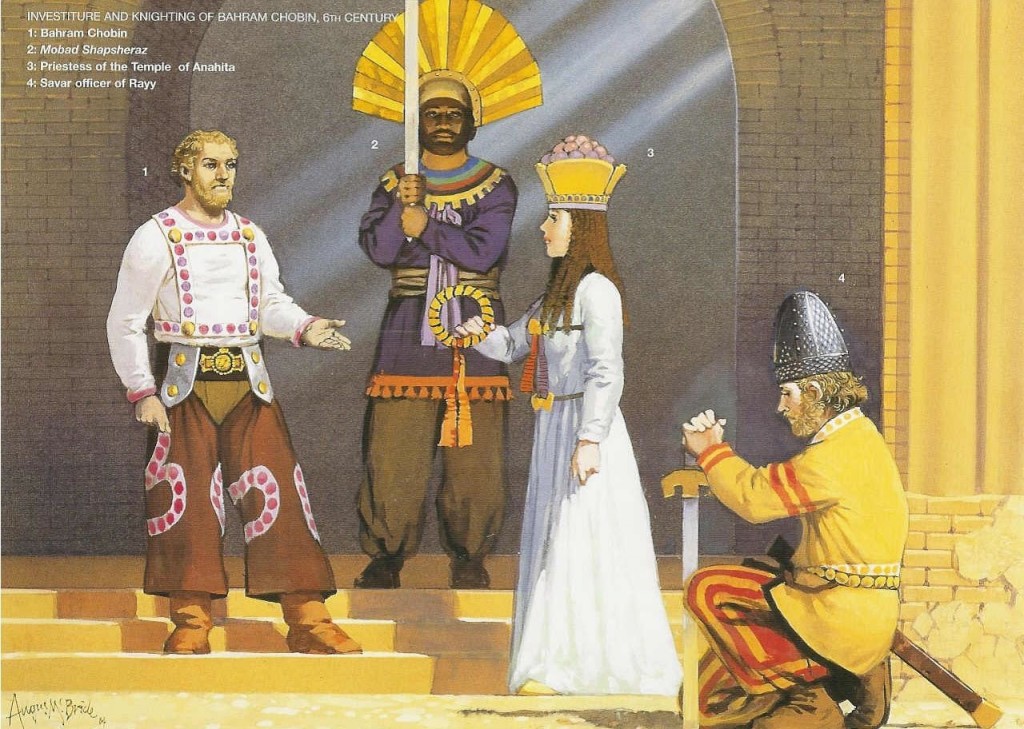 [Click to Enlarge] Recreation of the facade of a Sassanian palace and Bahram Chobin receiving a diadem (possibly representing the Farr or “Divine Glory”) from a priestess of the Anahita temple (Source: Kaveh Farrokh, Elite Sassanian Cavalry, 2005 –اسواران ساسانی–).
[Click to Enlarge] Recreation of the facade of a Sassanian palace and Bahram Chobin receiving a diadem (possibly representing the Farr or “Divine Glory”) from a priestess of the Anahita temple (Source: Kaveh Farrokh, Elite Sassanian Cavalry, 2005 –اسواران ساسانی–).
In the 2nd century CE, the centre of the cult in Parsa (Persia proper) was at Staxr (Istakhr). There, Anahita continued to be venerated in her martial role and it was at Istakhr that Sassan, after whom the Sasanian dynasty is named, served as high priest. Sassan’s son, Papak, likewise a priest of that temple, overthrew the King of Istakhr, a vassal of the Arsacids, and had himself crowned in his stead. “By this the beginning of the 3rd century, Anāhita’s headgear was worn as a mark of nobility,” which in turn “suggests that she was goddess of the feudal warrior estate” (Arjomand 1998, p. 248) – Ardashir (r. 226-241 CE) “would send the heads of the petty kings he defeated for display at her temple” (Arjomand 1998, p. 248 Cit Tabari, Annals 1:819).
During the reign of Bahram I (r. 272-273 CE), in the wake of an iconoclastic movement that had begun at about the same time as the shrine cult movement, the sanctuaries dedicated to a specific divinity were – by law – disassociated from that divinity by removal of the statuary and then either abandoned or converted into fire altars (Boyce 1975b, p. 462). So also the popular shrines to Mehr/Mithra which retained the name Darb-e Mehr – Mithra’s Gate – that is today one of the Zoroastrian technical terms for a fire temple. The temple at Istakhr was likewise converted and, according to the Kartir inscription, henceforth known as the “Fire of Anahid the Lady” (Boyce 1967, p. 36). Sasanian iconoclasm, though administratively from the reign of Bahram I, may already have been supported by Bahram’s father, Shapur I (r. 241-272 CE). In an inscription in Middle Persian, Parthian and Greek at Ka’ba of Zoroaster, the “Mazdean lord, …, king of kings, …, grandson of lord Papak” (ShKZ 1, Naqsh-e Rustam) records that he instituted fires for his daughter and three of his sons. His daughter’s name: Anahid. The name of that fire: Adur-Anahid.
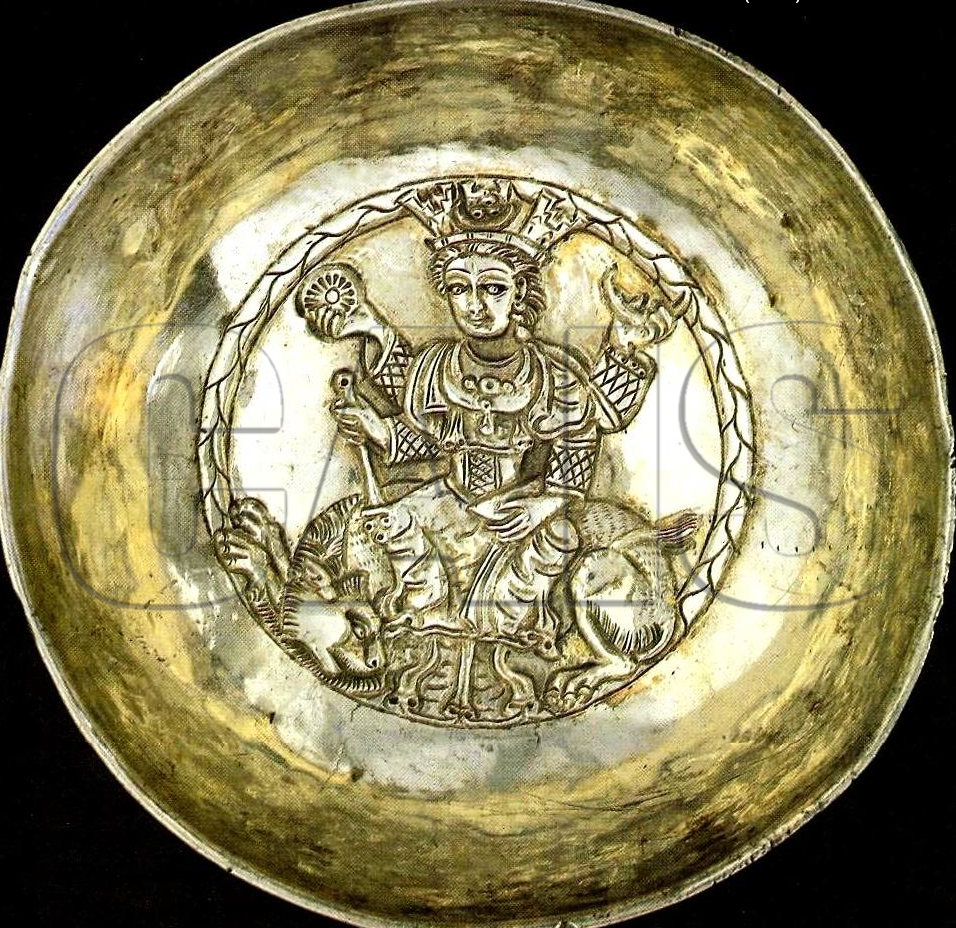 [Click to Enlarge] A 4th century Sassanian silver bowl featuring a high-relief decoration of the Goddess Anahita. She sits atop a lion and in her right hand is the sun (Photo Source: CAIS).
[Click to Enlarge] A 4th century Sassanian silver bowl featuring a high-relief decoration of the Goddess Anahita. She sits atop a lion and in her right hand is the sun (Photo Source: CAIS).
Notwithstanding the dissolution of the temple cults, the triad Ahura Mazda, Anahita, and Mithra (as Artaxerxes II had invoked them) would continue to be prominent throughout the Sasanian dynastic age, “and were indeed (with Tiri and Verethragna) to remain the most popular of all divine beings in Western Iran” (Boyce 1982, p. 210) Moreover, the iconoclasm of Bahram I and later kings apparently did not extend to images where they themselves are represented. At an investiture scene at Naqsh-e Rustam, Narseh (r. 293-302 CE) is seen receiving his crown from a female divinity identified as Anahita. Narseh, like Artaxerxes II, was apparently also very devoted to Anahita, for in the investure inscription at Paikuli (near Khaniqin, in present-day Iraq), Narseh invokes “Ormuzd and all the yazatas, and Anahid who is called the Lady” (Boyce 1967, p. 36).
Anahita has also been identified as a figure in the investiture scene of Khusrow Parvez (r. 590-628 CE) at Taq-e Bostan, but in this case not quite as convincingly as for the one of Narseh (Boyce 1983, p. 1008). But, aside from the two rock carvings at Naqsh-e Rustam and Taq-e Bostan, “few figures unquestionably representing the goddess are known” (Boyce 1983, p. 1008). The figure of a female on an Achaemenid cylinder seal has been identified as that of Anahita, as have a few reliefs from the Parthian era (250 BCE-226 CE), two of which are from ossuaries (Girshman 1962, fig. 120, 313).
In addition, Sasanian silverware depictions of nude or scantily dressed women seen holding a flower or fruit or bird or child are identified as images of Anahita (Boyce 1983, p. 1008, cit. Trever, À propos, plates XXVII-XXIX). Additionally, “it has been suggested that the colonnaded or serrated crowns [depicted] on Sasanian coins belong to Anahid” (Boyce 1983, p. 1008).
In Asia Minor and the Levant
The cult flourished in Lydia even as late as end of the Parthian epoch (Boyce 1983, p. 1006). The Lydians had temples to the divinity at Sardis, Philadelphia, Hierocæsarea, Hypaipa, Maeonia and elsewhere (Boyce 1983, p. 1006); the temple at Hierocæsarea reportedly (Tacitus, Annals 3.62) having been founded by “Cyrus” (presumably Cyrus the Younger, brother of Artaxerxes II, who was satrap of Lydia between 407 and 401 BCE “Boyce 1982, pp. 201-202”). In the second century CE, the geographer Pausanias reports having personally witnessed (apparently Mazdean) ceremonies at Hypaipa and Hierocaesarea (Pausanias, Description of Greece 7.27.5). According to Strabo, Anahita was revered together with Omanos at Zela in Pontus (Strabo Geographica 11.8.4; Strabo Geographica 12.3.37). At Castabala, she is referred to as ‘Artemis Perasia’ (Strabo Geographica 12.2.7). Anahita and Omanos had common altars in Cappadocia (Strabo Geographica XI 8.4, XV 3.15).
In Armenia and the Caucasus
“Hellenic influence [gave] a new impetus to the cult of images [and] positive evidence for this comes from Armenia, then a Zoroastrian land” (Boyce 1983, p. 1004). According to Strabo, the “Armenians shared in the religion of the Perses and the Medes and particularly honoured Anaitis” (Strabo Geographica 11.14.16). The kings of Armenia were “steadfast supporters of the cult” (Boyce 1983, p. 1007) and Tiridates III, before his conversion to Christianity, “prayed officially to the triad Aramazd-Anahit-Vahagn but is said to have shown a special devotion to ‘the great lady Anahit, … the benefactress of the whole human race, mother of all knowledge, daughter of the great Aramazd'” (Boyce 1983, p. 1007 Cit. Agathangelos 22). According to Agathangelos, tradition required the Kings of Armenia to travel once a year to the temple at Eriza (Erez) in Acilisene in order to celebrate the festival of the divinity; Tiridates made this journey in the first year of his reign where he offered sacrifice and wreaths and boughs (Agathangelos 21). The temple at Eriza appears to have been particularly famous, “the wealthiest and most venerable in Armenia” (Cicero, Pro Lege Manilia 9.23), staffed with priests and priestesses, the latter from eminent families who would serve at the temple before marrying (Strabo Geographica 11.14.16). This practice may again reveal Semitic syncretic influences, (Boyce 1983, p. 1007) and is not otherwise attested in other areas. Pliny reports that Mark Antony’s soldiers smashed an enormous statue of the divinity made of solid gold and then divided the pieces amongst themselves (Pliny Natural History 33.82-83). Also according to Pliny, supported by Dio Cassius, Acilisene eventually came to be known as Anaetica (Pliny Natural History 5.83; Dio Cassius, 36.48.1). Dio Cassius also mentions that another region along the Cyrus River, on the borders of Albania and Iberia, was also called “the land of Anaitis” (Dio Cassius, 36.53.5). “like Acilisene, it was doubtless the territory of a temple dedicated to Anahita but otherwise unknown” (Boyce 1983, p. 1007).
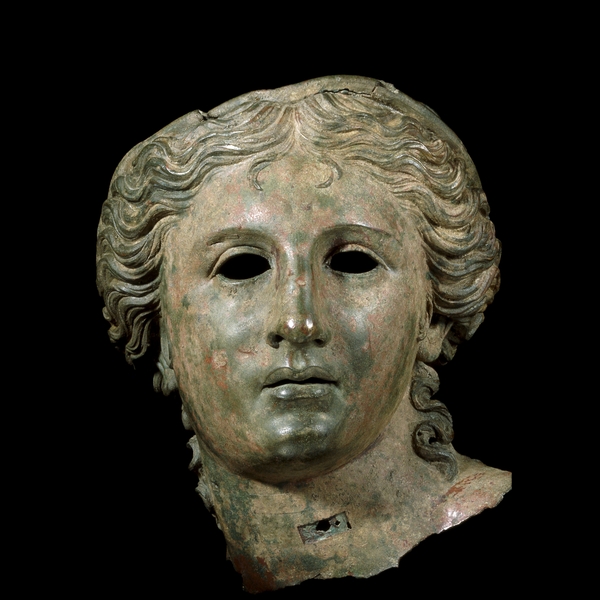 [Click to Enlarge] Armenian depiction of Goddess Anahit – Armenian equivalent of the Goddess Anahita (Picture Source: PeopleOfAr).
[Click to Enlarge] Armenian depiction of Goddess Anahit – Armenian equivalent of the Goddess Anahita (Picture Source: PeopleOfAr).
Anahit was also venerated at Artashat (Artaxata), the capital of the Armenian Kingdom, where her temple was close to that of Tiur, the divinity of oracles. According to Boyce, Tiur is Mesopotamian Nabu-*Tiri conflated with Avestan Tishtrya (Boyce 1982, pp. 32-33). In Hellenic (Seleucid and Parthian) times Tiur was associated with Pythian Apollo, patron of Delphi.
At Astishat, centre of the cult of Vahagn, she was revered as oskimyr, the ‘golden mother’ (Agathangelos, 141). In 69 BCE, the soldiers of Lucullus saw cows consecrated to ‘Persian Artemis’ roaming freely at Tomisa in Sophene (on the Euphrates in South-West Armenia), where the animals bore the brand of a torch on their heads (Plutarch, Lucullus 24.6). Following Tiridates’ conversion to Christianity, the cult of Anahit was condemned and iconic representations of the divinity were destroyed (Boyce 1983, p. 1007).
Attempts have been made to identify Anahita as one of the prime three divinities in Albania, but these are questionable. However, in the territories of the Moschi in Colchis, Strabo mentions (Strabo Geographica 11.2.17) a cult of Leucothea, which Wesendonck and others have identified as an analogue of Anahita (Boyce 1983, p. 1007).
Legacy
As a divinity Aredvi Sura Anahita is of enormous significance to the Zoroastrian religion, for as a representative of Aban (‘the waters’), she is in effect the divinity towards whom the Yasna service – the primary act of worship – is directed. “To this day reverence for water is deeply ingrained in Zoroastrians, and in orthodox communities offerings are regularly made to the household well or nearby stream” (Boyce 1975, p. 155). It is “very probable” (Boyce 1967, p. 37) that the shrine of Bibi Shahrbanu at royal Ray (Rhagae, central Media) was once dedicated to Anahita (Boyce 1967, p. 37). Similarly, one of the “most beloved mountain shrines of the Zoroastrians of Yazd, set beside a living spring and a great confluence of water-courses, is devoted to Banu-Pars, ‘the Lady of Persia'” (Boyce 1967, p. 38; Boyce 1983, p. 1005). In 1948, Persian scholar Abd al-Husayn Nava’i addressed the Shahrbanu legend and suggested that there must have been a Zoroastrian shrine at Ray whose sanctity attracted the legend (Boyce 1967, pp. 36-37). The shrine, which legend attributes to the eldest daughter of Yazdegerd III, continues to be a pilgrimage site (by women only, through a concession by male descendants of Mohammed) even in Islamic times (Boyce 1967, pp. 36-37). Boyce suggests that the shrine may be even older than the Sasanian dynastic period, dating perhaps to the Parthian dynastic era (Boyce 1983, p. 1004).
However, and notwithstanding the widespread popularity of Anahita, “it is doubtful whether the current tendency is justified whereby almost every isolated figure in Sasanian art, whether sitting, standing, dancing, clothed, or semi-naked, is hailed as her representation” (Boyce 1983, p. 1005; Jacobs 2006, p. 1).
Bibliography
Arjomand, Saïd Amir (1998), “Artaxerxes, Ardašīr, and Bahman”, JSTOR 118(2): pp.245-248
Bikerman, E. (1938), “Anonymous Gods”, Journal of the Warburg Institute 1(3): pp. 187-196
Boyce, Mary (1968), “Bībī Shahrbānū and the Lady of Pārs”, Bulletin of the School of Oriental and African Studies 30(1): pp. 30-44
Boyce, Mary (1975a), A History of Zoroastrianism, Vol. I, Leiden/Köln: Brill
Boyce, Mary (1975b), “On the Zoroastrian Temple Cult of Fire”, JSTOR 95(3): pp. 454-465
Boyce, Mary (1982), A History of Zoroastrianism, Vol. II, Leiden/Köln: Brill.
Boyce, Mary (1983), “Āban”, Encyclopaedia Iranica, New York: Mazda Pub.
Boyce, Mary (1983), M. L. Chaumont, & C. Bier, “Anāhīd”, Encyclopaedia Iranica, New York: Mazda Pub.
Cumont, Franz (1926), “Anahita”, in Hastings, James, Encyclopaedia of Religion and Ethics, Vol. I, Edinburgh: T. & T. Clark.
Dandamaev, Muhammad A & Vladimir G Lukonin (1989), The Culture and Social Institutions of Ancient Iran, New York: Cambridge.
Darmesteter, James (1892), “Le Zend-Avesta, I”, Annales du Musée Guimet 21.
Darrow, William R (1988), “Keeping the Waters Dry: The Semiotics of Fire and Water in the Zoroastrian ‘Yasna'”, Journal of the American Academy of Religion 56(3): pp. 417-442.
Girshman, Roman (1962), Persian art, Parthian and Sassanian dynasties, London: Golden Press.
Gray, Louis H (1926), “A List of the Divine and Demonic Epithets in the Avesta”, JSTOR 46: 97-153.
Jacobs, Bruno (2006), “Anahita”, Iconography of Deities and Demons in the Ancient Near East (Electronic Pre-Publication), Leiden: U Zürich/Brill.
Lommel, Herman (1927), Die Yašts des Awesta, Göttingen-Leipzig: Vandenhoeck & Ruprecht/JC Hinrichs.
Lommel, Herman (1954), “Anahita-Sarasvati”, in Schubert, Johannes & Schneider, Ulrich, Asiatica: Festschrift Friedrich Weller Zum 65. Geburtstag, Leipzig: Otto Harrassowitz.
MacKenzie, David Neil (1964), “Zoroastrian Astrology in the ‘Bundahišn'”, Bulletin of the School of Oriental and African Studies 27(3): pp. 511-529.
Meyer, Eduard (1886), “Anaitis”, Ausführliches Lexikon der griechischen und römischen Mythologie, vol. I, Leipzig: WH Roscher.
Monier-Williams, Monier (1898), A Sanskrit-English Dictionary, New York: OUP Nöldecke, Theodor (ed.) (1879), Geschichte der Perser und Araber zur Zeit der Sasaniden, Leiden: Brill (repr. 1973).
Nyberg, Henrik Samuel (1938), Die Religionen des alten Iran, Leipzig: JC Hinrichs.
Taqizadeh, Sayyid Hasan (1938), “Old Iranian Calendars”, Prize Publication Fund, Vol. 16, London: Royal Asiatic Society, Electronic Publication CAIS.
Widengren, Geo (1955), “Stand und Aufgaben der iranischen Religionsgeschichte: II. Geschichte der iranischen Religionen und ihre Nachwirkung”, Numen 2(1/2): pp. 47-134
Widengren, Geo (1965), “Die Religionen Irans“, Die Religion der Menschheit, Vol. 14), Stuttgart: Kohlhammer.

